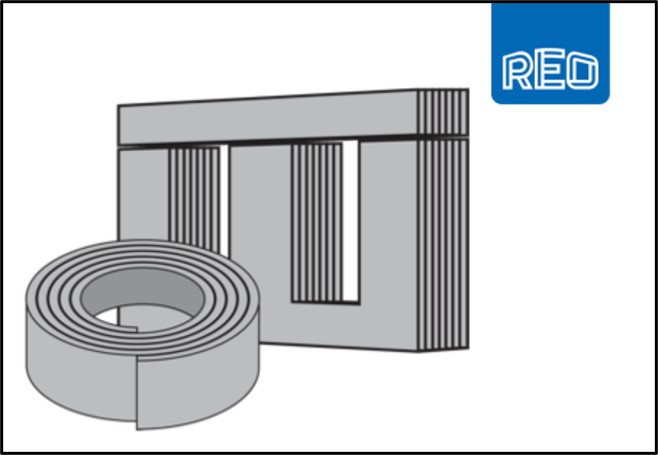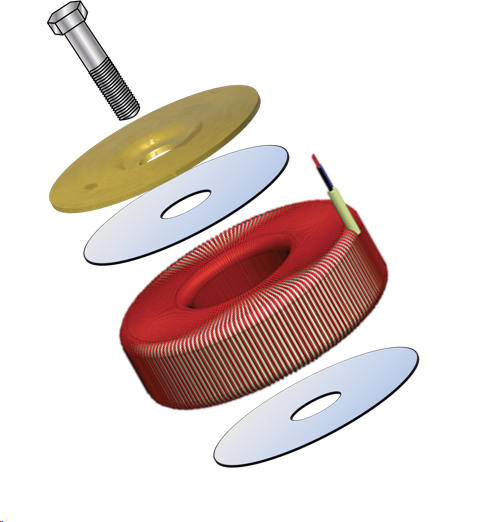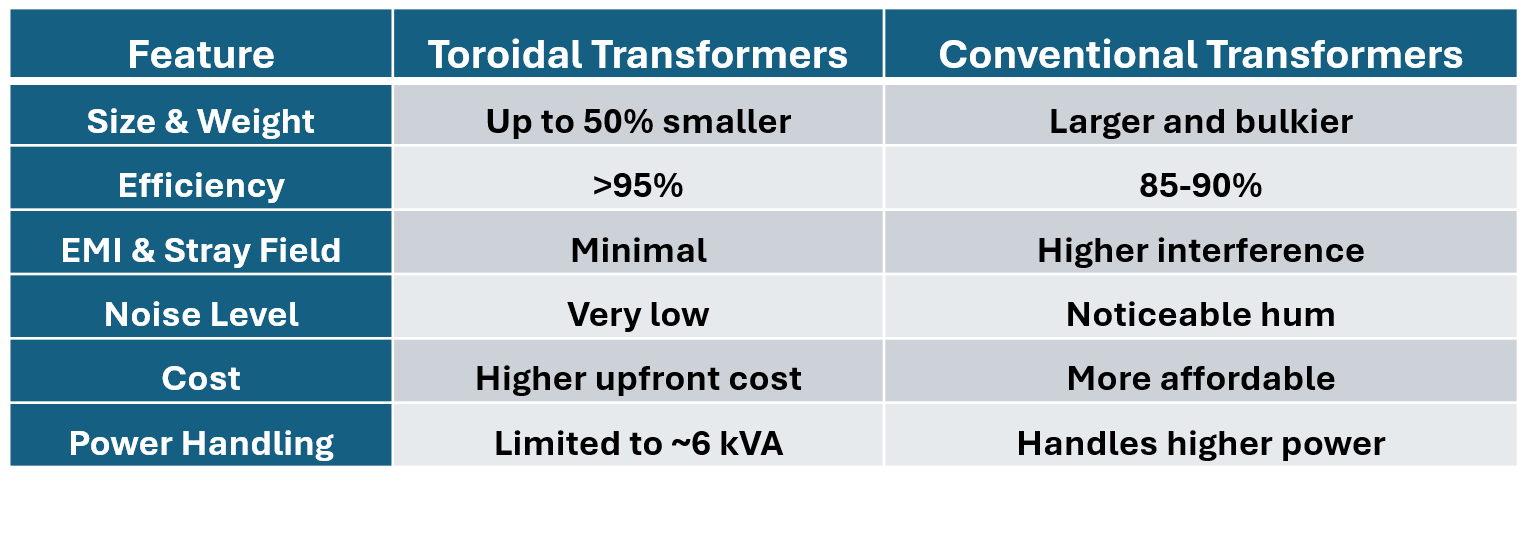Toroidal Transformers: An In-Depth Exploration
Downloads
| REO2025-10-Toroidal-Transformers.docx ( DOCX 242KB) |
| Figure-1.png ( PNG 27KB) |
| Figure-2.png ( PNG 179KB) |
| Figure-3.png ( PNG 174KB) |
| Figure-4.png ( PNG 51KB) |
Toroidal transformers: An in depth exploration
Toroidal transformers, with their distinctive doughnut-shaped cores, have gained popularity across multiple industries due to their compact design, high efficiency, and minimal electromagnetic interference (EMI). This article provides an extensive overview of their construction, advantages, disadvantages, applications, comparisons with conventional transformers, and the importance of choosing the right manufacturer.
Understanding Toroidal Transformers
A toroidal transformer consists of a circular (toroidal) core made from magnetic material, usually grain-oriented silicon steel. the primary and secondary windings are wrapped uniformly around this core, ensuring efficient magnetic coupling. This contrasts with conventional laminated core transformers, which use stacked steel laminations to create a magnetic path.
The primary function of any transformer is to transfer electrical energy between circuits while stepping voltage levels up or down and providing electrical isolation from the supply. Toroidal transformers achieve this with higher efficiency and lower losses due to their continuous path, which minimises air gaps and maximises flux linkage.
Advantages of Toroidal Transformers
- Compact and Lightweight Design
One of the primary benefits of toroidal transformers is their reduced size and weight. The circular core design allows for shorter winding lengths and increased flux density, leading to transformers that are up to 50% smaller and lighter than conventional transformers. This advantage makes them ideal for applications where space is critical, such as medical equipment and portable electronic devices.
- High Efficiency
Toroidal transformers typically operate at efficiency levels exceeding 95%. The continuous magnetic circuit minimises core losses, reducing energy waste. In contrast, standard laminated transformers often have efficiency ratings below 90%, making toroidal units the superior choice in modern power-sensitive applications.
High-quality toroidal transformers enhance efficiency further by utilising premium-grade magnetic core materials, precision winding techniques, and superior insulation. These elements reduce heat buildup and energy dissipation, allowing the transformer to deliver maximum power with minimal losses. Additionally, advanced manufacturing techniques, such as vacuum impregnation, improve the stability of the windings and prevent movement that could increase losses and audible noise.
In contrast, lower-quality transformers may suffer from increased energy wastage due to subpar core materials and inconsistent winding structures. This results in greater power loss, lower efficiency, and higher operating costs. Investing in a high-quality transformer ensures optimal performance, minimises energy consumption, and improves overall system longevity.
- Low Electromagnetic Interference (EMI)
EMI is a significant concern in electrical and electronic systems as stray magnetic fields can disrupt nearby circuits. Toroidal transformers have a closed-loop core structure that contains most of the magnetic flux within the transformer, drastically reducing stray electromagnetic emissions. This makes them particularly suitable for medical and audio applications where electromagnetic noise must be minimised.
- Minimal Audible Noise
Traditional transformers can produce an audible hum due to magnetostriction, where the core material expands and contracts under the influence of an alternating magnetic field. Toroidal transformers, by contrast, exhibit significantly lower levels of mechanical vibration, resulting in quieter operation. This is especially beneficial in noise-sensitive environments such as hospitals, recording studios, and audio equipment.
- Ease of Mounting
The compact nature of toroidal transformers allows for versatile mounting options. They can be affixed using a single central bolt or embedded within enclosures for additional protection, simplifying integration into electronic assemblies and enhancing mechanical stability.
Comparison with Conventional Transformers
Toroidal transformers outperform conventional laminated core transformers in several key areas. See Figure 4.
While toroidal transformers provide significant benefits, they are not always the best choice for every application due to inherent limitations.
Disadvantages of Toroidal Transformers
- Higher Cost
Toroidal transformers require more complex manufacturing processes than laminated-core transformers. The precision winding technique, specialised core materials, and additional labour increase the initial cost. However, the increased efficiency and longevity often offset this expense over time.
- Power Limitations
Most toroidal transformers are designed for applications up to 6 kVA. While they can be combined for higher-power applications, the winding techniques and thermal management challenges make them less practical for extremely high-power systems than their conventional counterparts.
- Complex Repair and Maintenance
Due to toroidal transformers’ tightly wound structure, repairing them can be challenging. If a winding is damaged, rewinding is far more complex compared to traditional laminated transformers, where the windings are more accessible.
- Sensitivity to Overvoltage
Toroidal transformers operate at higher flux densities, making them more susceptible to saturation under overvoltage conditions. If not properly managed, this can lead to performance degradation or failure.
Importance of Choosing High-Quality Transformers
Efficiency and Performance
High-quality transformers are designed with superior materials, ensuring reduced energy losses and optimal performance. For instance, using high-permeability silicon steel in the core minimizes hysteresis losses, while precision lamination techniques decrease eddy current losses. In contrast, lower-quality transformers often suffer from increased losses due to inferior materials, leading to higher energy consumption and reduced efficiency.
Thermal Management and Longevity
Effective thermal management is a key factor in transformer longevity and reliability. High-quality transformers are designed to handle heat dissipation efficiently, ensuring excessive temperatures do not degrade insulation or affect performance. Superior insulation materials, precise winding techniques, and high-grade cooling systems provide optimal temperature control, preventing potential overheating issues.
By investing in a high-quality transformer with superior thermal management, users benefit from prolonged operational lifespan, reduced maintenance needs, and more consistent performance under varying load conditions. This results in long-term cost savings and enhanced reliability in demanding applications such as industrial automation, medical equipment, and power distribution.
Conclusion
Toroidal transformers offer impressive benefits, including high efficiency, compact size, and low electromagnetic interference. Their advantages make them a superior choice for applications in various sectors. However, selecting a high-quality transformer over a lower-quality unit further amplifies these benefits, ensuring increased reliability, efficiency, and long-term performance.
While the upfront cost of a high-quality transformer may be more significant, the investment pays off through reduced energy losses, fewer maintenance issues, and improved system durability. As industries demand higher efficiency and performance, toroidal transformers will remain a cornerstone in electrical and electronic applications, driving advancements in energy management and power conversion technology.
To find more information on our range of toroidal core transformers, please visit https://www.reo.co.uk/types/transformers/toroidal-core-transformers/














